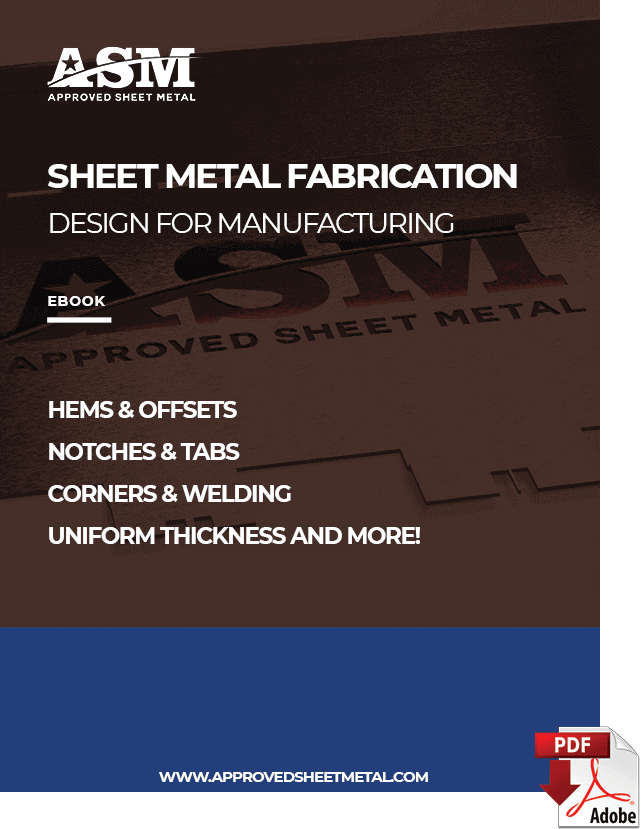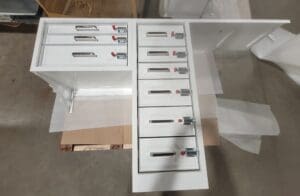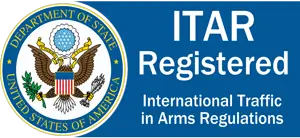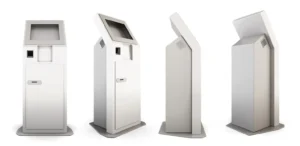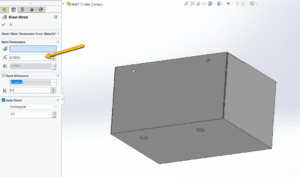Last updated on March 7th, 2025 at 09:05 am
Busbars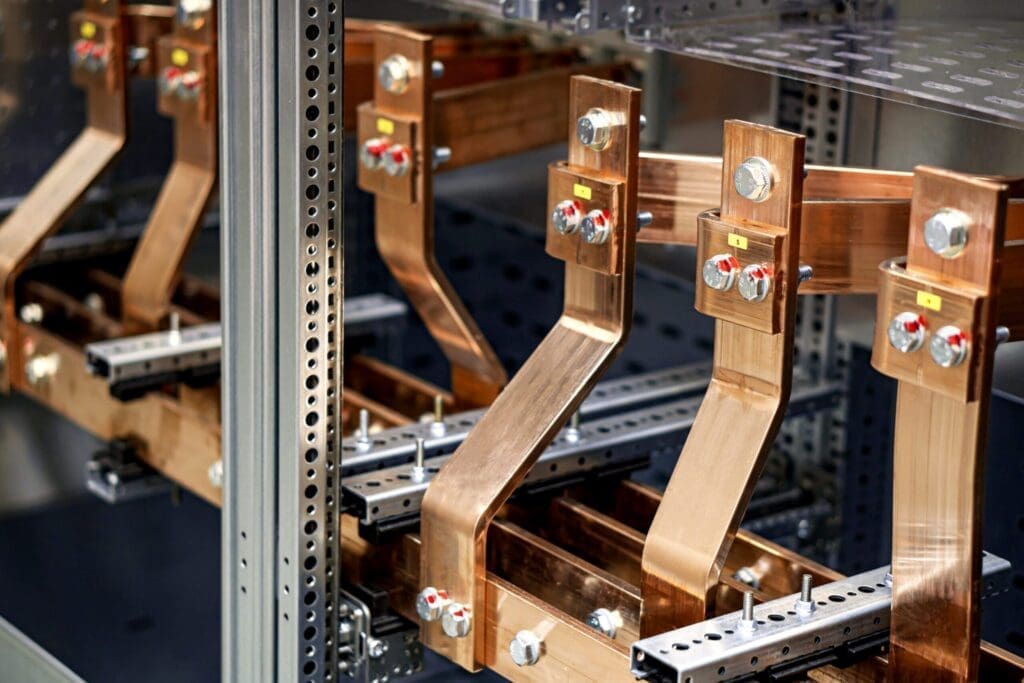 aren’t particularly complex or glamorous, but these simple metal bars are a powerhouse (quite literally) in electrical systems. From your local substation to mega-sized data centers, busbars play a crucial role in power distribution.
aren’t particularly complex or glamorous, but these simple metal bars are a powerhouse (quite literally) in electrical systems. From your local substation to mega-sized data centers, busbars play a crucial role in power distribution.
Here, we’ll dive into what busbars are, where they’re used, and how our sheet metal fabrication experts fabricate busbars, from one-off prototypes to low-volume production runs.
Table of Contents
- 1 Busbars: An Overview
- 2 Common Mistakes in Busbar Design
- 3 Sheet Metal Design for Manufacturing
- 4 Sheet Metal Busbar Design FAQ
- 4.0.1 What exactly are busbars, and why are they essential in electrical systems?
- 4.0.2 What materials are typically used in manufacturing busbars, and how do they differ in application?
- 4.0.3 Where are busbars used across industries, and what are their common applications?
- 4.0.4 What are the alternatives to busbars in electrical systems, and when might they be more suitable?
- 4.0.5 What fabrication capabilities does ASM offer for busbars, and what design considerations are important when requesting fabrication?
Busbars: An Overview
Think of busbars as the autobahn of electrical currents. Typically made from copper or aluminum, these precision sheet metal bars act as central hubs for electricity distribution, cleanly connecting a system’s various components, such as circuit breakers, switches, and fuses.
Without busbars, systems like electrical panels, switchgear, and distribution boards would require individually laid wires for every single component and connection—sounds chaotic, doesn’t it? Busbars streamline these connections neatly and efficiently.
Busbar Materials: Pick the Perfect Metal
Most busbars are made from copper or aluminum, two materials with excellent electrical conductivity and thermal properties. Your ultimate material selection should align with the application's requirements and constraints.
Choosing the right material for a busbar is like picking the right shoes for a hike. Copper is the all-terrain boot of busbars—the go-to standard for heavy-duty, high-current applications. Aluminum is your sneaker option: lightweight, lower cost, and functional, but better suited for less demanding applications.
Busbars at Work: Industries and Applications
You’ll find busbars used across a wide range of applications and industries, silently ensuring efficient electrical power distribution. Busbars are common in the aerospace, construction, marine, mining, telecommunications, and transportation industries where the most common applications include:
- Electrical panels and switchgear use busbars to distribute power within residential, commercial, and industrial buildings.
- Industrial machinery includes busbars for distributing power to equipment, motors, drives, and other machinery.
- Power distribution systems such as substations and power generation facilities use busbars to interconnect transformers, circuit breakers, and other components.
- Data centers use busbars to distribute a stable power supply to servers, storage systems, and networking equipment.
- Renewable energy systems use busbars to connect and transport generated power to the grid or storage systems.
Busbar Alternatives: Solutions for Electrical Systems
There are no true “alternatives” for busbars, but other electrical systems may be the right choice for certain applications. Wiring harnesses, for instance, are an excellent choice when an application requires routing flexibility. Other electricity distribution solutions include:
- Conduit systems
- Electrical bus ducts
- Power distribution blocks
- Power distribution units (PDUs)
- Power strips
- Printed circuit boards (PCBs)
- Terminal blocks
- Wireless power transmission
- Wireways and cable trays
Every solution offers specific advantages and limitations, so you should carefully assess your application’s needs before choosing one method over another.
Busbar Finishing: Coatings and Insulation
Here at ASM, we’re best known for our speed in fabricating precision sheet metal parts. To keep your sheet metal fabrication lead times short, we nearly always ship busbars raw—no coating or insulation.
But if time isn’t a factor, ASM can provide select types of plating, such as nickel-copper plating. We do not, however, work with silicone rubber or heat-shrink tubing.
When you’re deciding whether to coat or plate your busbars, consider the electrical system and any risks associated with leaving the busbars exposed. Safety and regulatory requirements are two of the top reasons you may want to coat or insulate a busbar!
Busbars in the Shop: ASM’s Capabilities
Our expert sheet metal fabrication team fabricates busbars in-house using three primary capabilities.
- We use a turret punch to cut busbars with simple geometry
- We use a laser cutter to achieve more complete busbar features
- We use a press brake after cutting to obtain your precise busbar form
Busbar Tips: Design for Manufacturing (DFM)
When you’re designing a busbar, these DFM tips will help us deliver exceptional quality—fast.
Tolerances. Design your busbars with standard manufacturing tolerances. We commonly receive callouts for tight tolerances that simply aren’t possible to achieve, and standard tolerances are essentially always acceptable for busbars.
Materials. Design for common, readily available material thicknesses. If you request a material that’s difficult to obtain, your lead time could extend significantly.
Tooling. Design with standard tooling in mind whenever possible. If we need to order or machine custom tools to fabricate your busbar, your cost and lead time will increase.
Common Mistakes in Busbar Design
Even though busbars are relatively simple components, design mistakes can lead to performance issues, higher fabrication costs, and extended lead times. Here are some of the most common mistakes we see—and how to avoid them.
1. Overly Tight Tolerances
Many designs call for tolerances that are unnecessarily tight or even unachievable with standard sheet metal fabrication processes. While busbars require precision, standard tolerances (typically ±0.010” to ±0.020”) are sufficient for most applications. Tightening tolerances beyond what’s necessary can drive up costs and lead times.
✅ Tip: Stick to standard tolerances unless absolutely required by your application. If you need a tighter tolerance, consult with your fabricator first.
2. Poor Hole Placement
Holes that are too close to the edge of a busbar can cause distortion during bending or punching. Additionally, hole sizes that don’t align with standard tooling can increase costs due to the need for custom punches or secondary machining.
✅ Tip: Keep holes at least 1.5 times the material thickness away from edges and bends. Also, use standard hole sizes whenever possible.
3. Incorrect Material Selection
Choosing the wrong material can lead to performance issues. For example, while aluminum busbars are lighter and more cost-effective than copper, they have higher resistance and require different connection methods.
✅ Tip: Consider factors like conductivity, thermal expansion, and corrosion resistance when selecting materials. Copper is preferred for high-current applications, while aluminum is a more economical choice for less demanding environments.
4. Ignoring Insulation and Coating Needs
Uncoated busbars may be prone to oxidation, corrosion, or short circuits, depending on their environment. Some applications require tin, silver, or epoxy coatings for longevity and conductivity, but these are often overlooked in the design phase.
✅ Tip: Evaluate whether your application requires insulation or plating, and specify coatings early in the design process to avoid last-minute delays.
5. Designing for Non-Standard Thicknesses
Specifying a non-standard material thickness can significantly increase lead times and costs, as it may require special material orders or additional processing.
✅ Tip: Choose commonly available thicknesses, such as 0.125”, 0.187”, or 0.250”, to ensure faster turnaround and lower costs.
6. Overcomplicating the Design
Adding unnecessary bends, cutouts, or complex geometries can increase fabrication difficulty and cost. While some design features may be necessary, simplifying the layout where possible helps reduce production time.
✅ Tip: Optimize your design for manufacturability by limiting excessive bends, sharp internal corners, and intricate details that require special tooling.
By avoiding these common mistakes, you can ensure your busbars are cost-effective, manufacturable, and optimized for performance. If you have questions about your design, our team at ASM is here to help!
Request a quote for your busbar project, and you’ll hear from us soon!
Sheet Metal Busbar Design FAQ
Busbars are metal bars, commonly made of copper or aluminum, that serve as central hubs for distributing electrical currents. They streamline connections between various components like circuit breakers and switches, significantly simplifying power distribution in electrical systems.
Copper and aluminum are the primary materials used due to their excellent electrical conductivity and thermal properties. Copper, akin to an all-terrain boot, is ideal for heavy-duty, high-current applications. Aluminum, more lightweight and cost-effective, suits less demanding scenarios.
Busbars find applications in diverse industries like aerospace, construction, data centers, and renewable energy systems. They're employed in electrical panels, industrial machinery, power distribution systems, and even in connecting renewable energy sources to the grid.
While there are no direct substitutes for busbars, alternative solutions like wiring harnesses, conduit systems, PCBs, or power distribution blocks offer advantages in specific scenarios. For instance, wiring harnesses excel in applications that demand routing flexibility.
ASM employs turret punches and laser cutters to craft busbars, ensuring precision and customization. Designing busbars with standard tolerances, readily available material thicknesses, and considering standard tooling helps expedite fabrication while minimizing costs and lead times.

